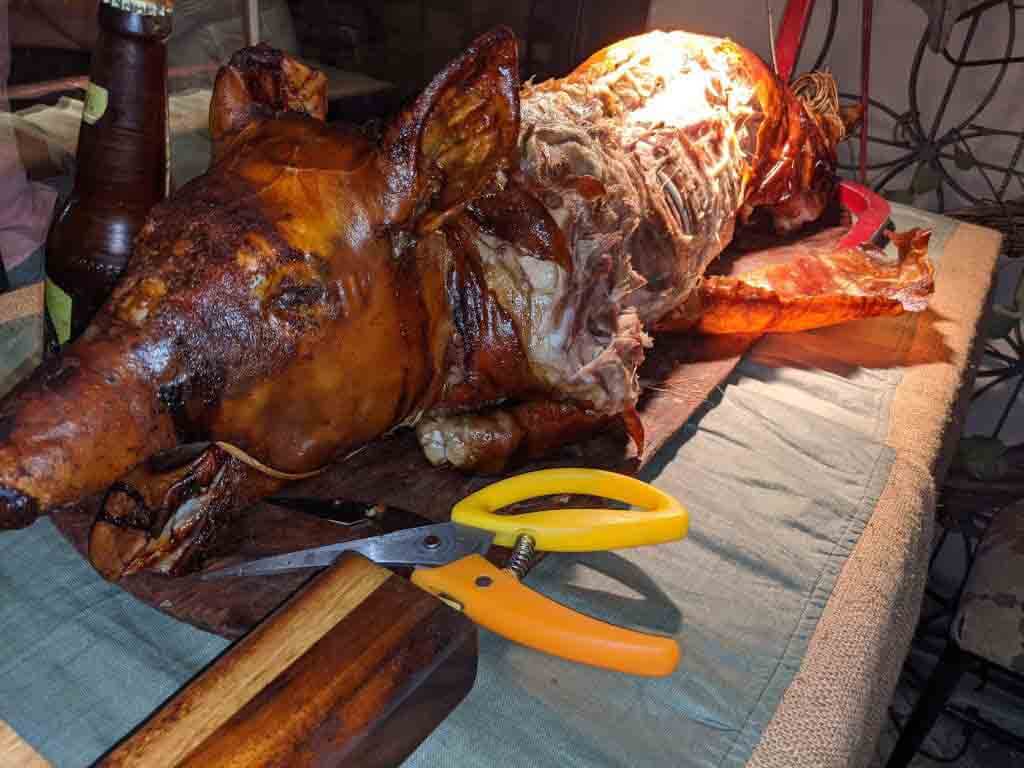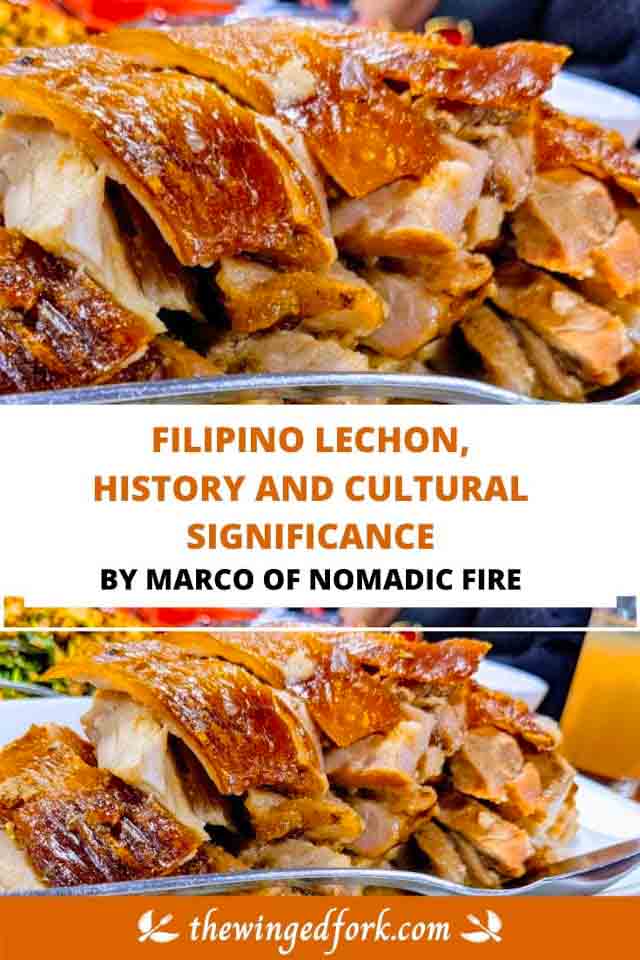It has been 120+ years since the Philippines was a Spanish colony. But after 333 years of colonialism, Spanish influence is still ever-present in Filipino culture. Many of the Philippines’ signature foods have Spanish roots. Leche flan, empanada, chicharron, and picadillo are just a culinary sampler, but lechon is the star.
What is Filipino Lechon?

Lechon is derived from the Spanish word leche, with translates to milk. The origin of the dish used small young suckling pigs that were still nursing milk from their mothers. As Lechon’s popularity increased, cooks moved to use bigger pigs. Now, lechon simply refers to a spit-roasted pig slowly rotisseried over open coals. And although the Philippines does not have a national dish, the lechon comes as close to one as the adobo does.
History and Memories of Filipino Lechon
Every Filipino family has their secret twist. My family recipe stuffed the pig with lemongrass, bay leaves, and other aromatics before cooking. Nouveau Filipino foodies have experimented with fusing lechon with Chinese cooking(lap cheong and salted eggs) and even French (truffled rice) cooking. In the Philippines, Cebu is known country-wide as having the best version of this signature dish. None other than famed celebrity chef Anthony Bourdain (RIP) dubbed Cebu lechon as “The best pork ever.”
My retired life in Manila, Philippines, is affordable enough that I can eat out seven times a week. My “eating out” budget allows me an opportunity to try different restaurants in search of the best lechon. While I enjoy devouring the variety of roasted pork (even if my waistline doesn’t), eating at a restaurant has a sterile feel to it. See, to me, lechon is about the experience. No restaurant in the world delivers the same experience as a family celebration.
As a developing country, with over 15% of our population still in poverty, buying, preparing, and cooking an entire pig is only done on special occasions. If a family is serving lechon, it means we’re not just having a small get together; we are having a blowout celebration. Weddings, reunions, milestone birthdays, or debuts (a Filipino version of a Spanish Quinceañera) are all reasons to throw a pig on the fire. So when I think about lechon, I’m not picturing some haute bistro’s Filipino-French fusion version of the dish. I’m imagining mom’s home cooking and being surrounded by family.
Traditionally Cooked Filipino Lechon

Lechon is me playing in the backyard with my cousins during a party. I hear my mom and aunties in the kitchen gossiping while finishing up the pancit, adobo, and kare-kare. Any of those dishes would be the main entrée on other days of the week. But on a special day like today, those everyday Filipino staples take a backseat to the pig.
The pig is outside being tended to by the men. The uncles, cold beers in hand, stand guard and hypnotically watch the pig rotate over the hot red embers. It takes about 4-5 hours to slow cook a big pig properly. Every hour is worth it as the meat stays moist, but the skin comes out crackling and crispy to the touch.
Finally, the lechon is done and ceremoniously placed at the end of the table. My family serves the food buffet style, so my cousins and I crowd the table, jostling for position. All the elbowing is for naught, as Lolo and Lola (grandpa and grandma) always get first dibs through the line. After patiently waiting for the elders to take their share, I hungrily take my turn through the buffet. I choose some rice, some lumpias (Filipino eggrolls), pancit (Filipino stir-fried noodles), then my uncle carves and dishes me up several slices of lechon.
I warily walk back to my seat. Lechon piled high on my food. My feet swing happily as I dig into my meal. The lechon skin, reddish caramel in color from the hours over the coals, has the taste and texture of deep-fried bacon flavored potato chips. The pork meat itself is moist and bursting with smokey roasted goodness. The juicy flavors mingle as I chew. The grassy flavors of bay leaves and lemongrass blend with sweet tamarind and star anise.
Since moving back to retire in the Philippines, my appreciation for Filipino foods has become more than just about taste. I’m more aware of how much our food traditions mean to us culturally. Family celebrations are why lechon means so much in the Philippines. To non-Filipino’s, lechon is tasty roasted meat. To me, lechon is a celebration of family. It’s ignoring the financial hardships and drudgery of low-paying jobs. For that day, for that party, we are rich and want to share our bounty with the entire family.
About Marco Sison, Nomadic FIRE

I am a refugee from the drab cubicle walls of US corporate finance. Tired of the grind from 70-hour weeks to pay off a mortgage, a car, student loans, and countless bills, I said screw it all and retired early at 41 years old.
I started Nomadic FIRE to provide simple, low-cost strategies to save for retirement. Nomadic FIRE is a lifestyle combining digital nomad slow travel and the investing principles of the Financial Independence Retire Early (FIRE) movement. I have traveled the last five years to over 40 countries to bring you the best ways to save, invest, and live in amazing countries for 70% less cost than the US. Find me on Instagram.
Other Foodie Posts to Read
- Things to do in Sagada
- Where to Eat in Nashville, TN
- What to Eat in Tbilisi, Georgia
- What to Eat in Switzerland
- What to eat in Sicily: Top 16 Dishes to Try


